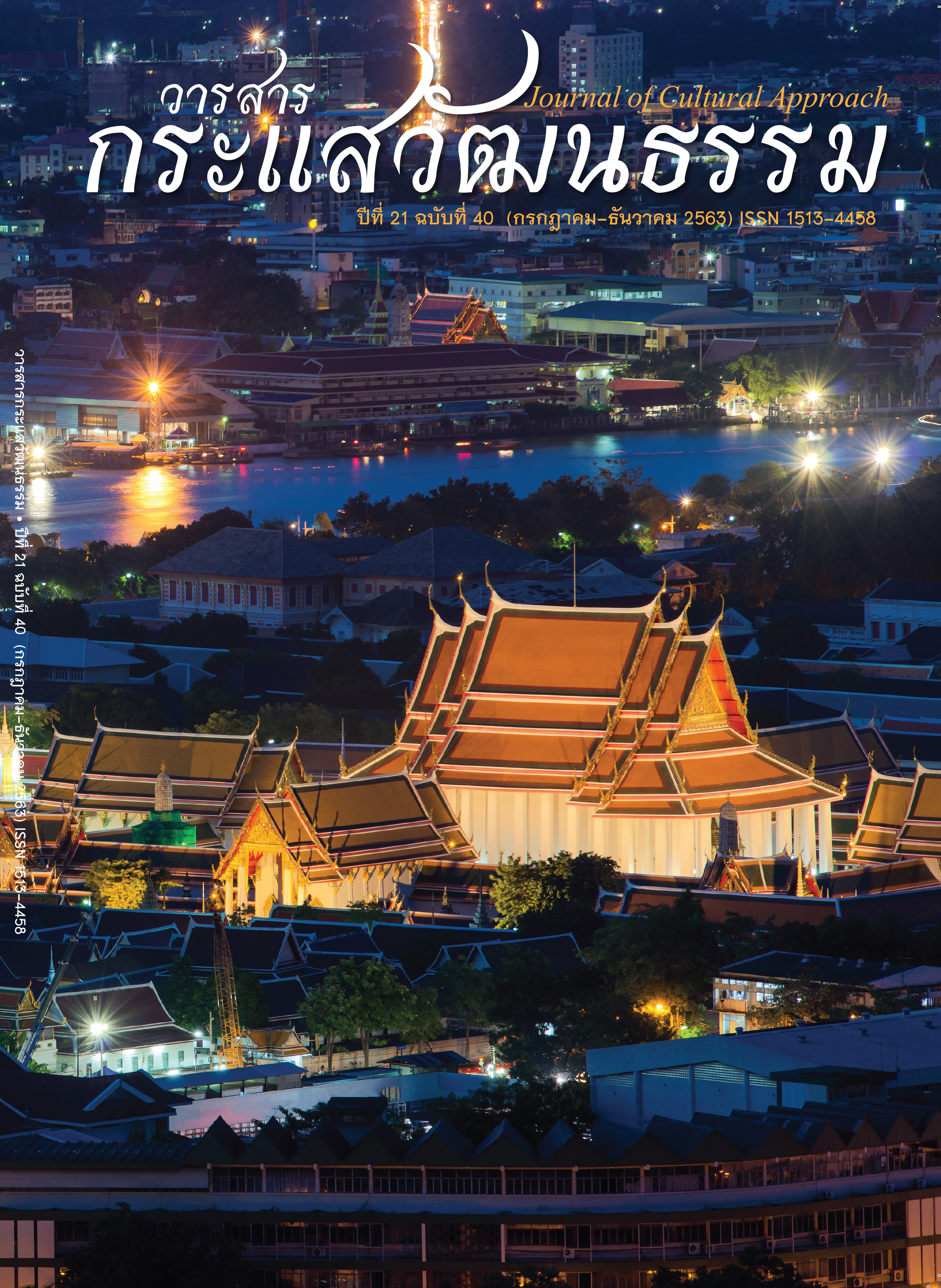การพัฒนาศักยภาพกิจกรรมการท่องเที่ยวเชิงสร้างสรรค์ของกลุ่มชนไทยทรงดำ
Main Article Content
บทคัดย่อ
กลุ่มชนไทยทรงดำที่อาศัยอยู่ในตำบลบ้านดอน อำเภออู่ทอง จังหวัดสุพรรณบุรี มีการสืบทอดวัฒนธรรมดั้งเดิมมาจากบรรพบุรุษ โดยสิ่งที่แสดงถึงเอกลักษณ์ดั้งเดิม ประเพณีวัฒนธรรมและวิถีชีวิต ได้แก่ การแต่งกาย ลายผ้า ภาษา อาหาร บ้านเรือน ประเพณี และอาชีพ ซึ่งหน่วยงานภาครัฐในพื้นที่มีนโยบายที่จะพัฒนาท้องถิ่นให้เป็นแหล่งท่องเที่ยว เช่นเดียวกับกลุ่มชนไทยทรงดำในชุมชนที่ต้องการอนุรักษ์และเผยแพร่วัฒนธรรมของตนผ่านกิจกรรมการท่องเที่ยว คณะผู้วิจัยจึงได้ทำการศึกษาโดยใช้วิธีการวิจัยและพัฒนา 4 ขั้นตอน เพื่อหาแนวทางการพัฒนาศักยภาพกิจกรรมการท่องเที่ยวเชิงสร้างสรรค์ของกลุ่มชนไทยทรงดำ ตำบลบ้านดอน ผลการศึกษาพบว่า วัฒนธรรมที่สามารถนำมาพัฒนาเป็นกิจกรรมการท่องเที่ยวเชิงสร้างสรรค์ ได้แก่ การย้อมผ้า การเรียนภาษาไทดำ และการเย็บลายดอก โดยนักท่องเที่ยวมีความพึงพอใจต่อทั้ง 3 กิจกรรมในระดับมาก และผู้ทรงคุณวุฒิมีความคิดเห็นว่าการจัดกิจกรรมมีความเหมาะสมในระดับมากที่สุด ส่วนแนวทางการพัฒนาศักยภาพกิจกรรมการท่องเที่ยวเชิงสร้างสรรค์ของกลุ่มชนไทยทรงดำ ตำบลบ้านดอน มี 4 ประการ ประกอบด้วย ด้านผู้ถ่ายทอดวัฒนธรรม ด้านรูปแบบกิจกรรม ด้านสื่อการนำเสนอ และด้านสภาพแวดล้อม
Article Details
Proposed Creative Commons Copyright Notices
1. Proposed Policy for Journals That Offer Open Access
Authors who publish with this journal agree to the following terms:
- Authors retain copyright and grant the journal right of first publication with the work simultaneously licensed under a Creative Commons Attribution License that allows others to share the work with an acknowledgement of the work's authorship and initial publication in this journal.
- Authors are able to enter into separate, additional contractual arrangements for the non-exclusive distribution of the journal's published version of the work (e.g., post it to an institutional repository or publish it in a book), with an acknowledgement of its initial publication in this journal.
- Authors are permitted and encouraged to post their work online (e.g., in institutional repositories or on their website) prior to and during the submission process, as it can lead to productive exchanges, as well as earlier and greater citation of published work (See The Effect of Open Access).
Proposed Policy for Journals That Offer Delayed Open Access
Authors who publish with this journal agree to the following terms:
- Authors retain copyright and grant the journal right of first publication, with the work [SPECIFY PERIOD OF TIME] after publication simultaneously licensed under a Creative Commons Attribution License that allows others to share the work with an acknowledgement of the work's authorship and initial publication in this journal.
- Authors are able to enter into separate, additional contractual arrangements for the non-exclusive distribution of the journal's published version of the work (e.g., post it to an institutional repository or publish it in a book), with an acknowledgement of its initial publication in this journal.
- Authors are permitted and encouraged to post their work online (e.g., in institutional repositories or on their website) prior to and during the submission process, as it can lead to productive exchanges, as well as earlier and greater citation of published work (See The Effect of Open Access).
References
Florida, R. (2002). The Rise of the Creative Class: And How It’s Transforming Work, Leisure, Community and Everyday Life. New York: Basic Books.
Kiralova, A. (2017). Driving Tourism through Creative Destinations and Activities. Pennsylvania, USA: IGI Global.
Krajnovic, A. & Gortan–Carlin, I. P. (2007). Possibilities of Music Heritage Tourist Valorization: An Example of Istria. Tourism and Hospitality Management, 13(2), 469–482.
Luxana Keyuraphan et al. (2016). A Development Model of Thai Phuan Community’s Tourism Activity Management to Promote Creative Learning in Nakhon Nayok. Veridian E–Journal, 9(2), 2190–2201.
Manassinee Boonmeesrisanga. (2015). Patterns Meaning and Strategy of Dark Tourism Marketing in Kanchanaburi, Thailand. Veridian E–Journal, 8(2), 571–592.
Ministry of Culture. (2011). Thai Song Dam. Retrieved June 1, 2015 from http://www.mculture.in.th/moc_new/album/14207
Ministry of Tourism and Sports. (2018). Press Conference: Tourism Situation 2018. Retrieved February 16, 2018 from https://www.mots.go.th/ewt_dl_link.php?nid=9882
Nalikatipak Saengsanit. (2012). DASTA and Thammasat University Announced to Development of Creative Tourism for the Sustainable Community. Retrieved May 15, 2015 from http://www.dasta.or.th/th/item/201–201
National Statistical Office. (2017). Survey of Travel Behavior of Thai People in 2016. Bangkok: Statistical Forecasting Division.
Pattarapong Inkumnerd et al. (2010). Innovative Systems for Developing A Creativity Knowledge-Based Economy: A Case Study of Creative Tourism Industry. Office of the Educational Council.
Pisarn Kaew–Yu & Prakobsiri Pakdeepinit. (2014). Guideline for Development Creative Tourism through Adapter Using Hyacinth Handicraft in Muang District, Phayao Province, Thailand. (pp.321–329). Paper presented in 4th Conference on Sustainable Rural Development “Rethink: Social Development for Sustainability in ASEAN Community” 11–13 June 2014.
Ratchada Jirathamakul. (2016). The Development Guidelines of Creative Cultural Community–Based Tourism of Ban Ka–nan Community, Thalang District, Phuket Province. Journal of Cultural Approach, 17(31), 3–17.
Richards, G. (2011). Creativity and Tourism: The State of the Art. Annals of Tourism Research, 38, 1225–1253.
Richards, G. & Marques, L. (2012). Exploring Creative Tourism: Editors Introduction. Journal of Tourism Consumption and Practice, 4(2), 1–11.
Richards, G. & Raymond, C. (2002). Creative Tourism. ATLAS News, 23, 16–20.
Salman, D. & Uygur, D. (2010). Creative Tourism and Emotional Labor: An Investigatory Model of Possible Interactions. International Journal of Culture Tourism and Hospitality Research, 4(3), 188–197.
Suddan Wisudthiluck et al. (2015). Creative Tourism. 2nd ed. Bangkok: Designated Areas for Sustainable Tourism Administration.
Sutsan Suttipisan. (2011). Deployment World Heritage Sites for Creative Tourism. Bangkok: Center of Integrated Tourism Management Studies, National Institute of Development Administration.
Tan, S. K., Kung, S. F., & Luh, D. B. (2013). A Model of ‘Creative Experience’ in Creative Tourism. Annals of Tourism Research, 41, 153–174.
Taylor, C. W. (1988). Various Approaches to and Definitions of Creativity. In Sternberg, R. J. (ed.), The Nature of Creativity: Contemporary Psychological Perspectives (pp. 99–121). Cambridge University Press.
Thanakrit Pattarathorn. (2015). Seminar on Creative Tourism to Create Thai Tourism. Bangkok University.
Thawi Swangpanyangkoon. (2010). Kwam to Muang Tai Song. Silpakorn University Journal, 30(2), 41–56.
Tinnakrit Rungmuang. (2015). The Model Development of Creative Tourism in order to Enhance the Network of Tourism Activities of DVARAVATI Four Provinces. Romphruek Journal, 33(1), 138–160.
Vuttichat Soonthonsmai & Piyaporn Thammachart. (2016). Community–Based Healthy Tourism Patterns for Sustainable Development of Community–Based Enterprise Networking in Prajinburi Province. Journal of the Association of Researchers, 21(3), 167–181.
Wichuda Roiphila & Preeda Chaiya. (2015). Tourism Resources Components Affecting Creative Tourism in Kalasin. VRU Research and Development Journal Humanities and Social Science, 10(3), 197–211.
Wurzburger, R. & et al. (2010). Creative Tourism: A Global Conversation: How to Provide Unique Creative Experiences for Travelers Worldwide. Santa Fe: Sunstone.

